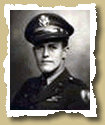| The Assault | Timeline | Maps | Men of D-Day | Photos |

|
As a C-47 pilot I flew two missions on June 6, 1944, to support of the 101st Airborne Division. Other crew members were 2Lt Thomas L. D. Foreman, copilot, T/Sgt Hipolito Gonzales, crew chief, and S/Sgt Clarence LeBeau, radio operator. I was assigned to the 434th Troop Carrier Group, 73rd T.C. Squadron, 9th Air Force. The 434th was activated on 30 January 1943, and moved to Fullbeck, England, in October to train with the 101st. In March 1944, the Group moved to Aldermaston, about 50 miles west-southwest of London. There, training in "vertical envelopment", i.e. parachute and glider infantry exercises, continued with the 101st. The runway at Aldermaston was broadened on each side with PSP {perforated steel planking) to enable 52 aircraft to be mated with gliders and aligned for rapid launch. On June 4th we were briefed on "Overlord" as well as our specific missions, "Chicago" and "Keokuk". Security was incredibly tight following briefing. Military police of the 101st had completely closed the base perimeter. To use the latrine, located in another building, one was escorted between buildings by an armed guard. Below minimum weather conditions then forced a delay of 24 hours. A reconnaissance update disclosed that our primary landing zone (LZ) had been changed. Field Marshall Rommel, who had been rushing Normandy defenses for days, had erected poles in the area, denying its use for glider landings. Following briefing on the 4th, we were driven to the dispersed aircraft parking areas where we found buckets of white and black paint. We then painted three broad stripes about a foot wide on each wing and fuselage, two white separated by a black one. Instant aircraft recognition, friend or foe, was of course critical in an operation involving some 3000 allied aircraft. We mustered on the flight line sometime before midnight on the 5th, preflighting the aircraft, synchronizing watches, and sipping a last cup of Red Cross coffee. Aircrew were assigned specific planes when flights were organized months earlier, and regarded them as personal property. Mine was C-47 43-16052, with CN painted on the nose to designate the 73rd squadron, and the letter O (Oboe) on the tail as its call sign. As we made final exterior flight checks, Lt Gen. Louis Brereton, tactical expert in airborne, paced the flight line talking to crews, offering encouragement, wishing us "Godspeed". As I boarded the aircraft, I found Tommy Foreman kneeling in silent prayer in the cabin. I recall patting his shoulder as I stepped by to the cockpit. It had been a number of years since I had any dialogue with God, and I think I felt it would be hypocritical to ask for special favors now. I don't recall whether plane losses were estimated at briefing, but I did form my own estimate: 5% as an optimistic one and 15% as pessimistic. I recall a sense of something like fear, but it was overridden by the excitement of being part of the greatest military event ever. Engine start was at 0100 hours. Takeoff for "Chicago" was at 0119 hours. The CG4-A glider mated with our aircraft was loaded with a 6 lb. field gun, ammunition and a three man crew. The glider crew, Flight Officer Leon C. Doelger, pilot, and Flight Officer M. A. Trechak, copilot. We flew in absolute radio silence and without running lights in four ship flights of two ship elements. To maintain position in night formation, there were six low intensity blue lights on the upper surface of the wing. Our southwesterly heading took us to a point just east of Guernsey and then just south of Jersey in the English Channel. We then approached Normandy and our LZ near Ste. Mere Eglise on an easterly heading. At landfall we encountered moderately heavy ground fire, but tracers indicated it was arcing ahead of the aircraft, possibly because of the much reduced speed with gliders in tow. We reached our landing zone about 0400 hours. We signaled release to the glider crew by aiming a green light through the plane's astrodome. I silently wished my own "Godspeed" to the occupants as they descended in the predawn light. (Ten days later both glider pilots were safely recovered and back at Aldermaston, operationally ready.) For defense against ground fire I took the plane down to near tree top level and broke out over Utah Beach shortly afterward. The massive array of Navy craft lay silent and blacked out at that time. We headed north and home. Back at Aldermaston we were debriefed by intelligence--after a welcome shot of Scotch whiskey. Later we learned we suffered only one aircraft loss of 50 launched, however, seven C-47s and 22 gliders were hit by ground fire. We flopped into bed to rest before a scheduled briefing for the second mission, "Keokuk". I found it somewhat difficult to sleep thinking of the heightened action which must then be underway in Normandy. "Keokuk" launched at 1830 hours. Thirty-two C-47s towing the much larger British Horsa gliders participated. Glider L894 was mated with our plane, with seven 101st crew, a truck, a 37mm field gun, radio batteries, ammunition, fuel, and accessories, plus the glider pilots. Glider release over Normandy was about 2100 hours (still bright sunlight) and the action intense. I recall the sight of one of the plywood-constructed Horsas being splintered by automatic weapons fire from nose to tail just as it completed its landing skid. Ninety percent of the gliders were destroyed, 14 glider crew were killed in landing crashes and enemy fire, 20 were seriously injured and 10 missing in action. The 434th was later awarded the French Croix de Guerre with Palm, the Bronze Arrowhead (for Spearhead Assault) as well as the United States Distinguished Unit Citation. John R. Devitt, Lt Colonel, USAF (Ret.) |
| |
